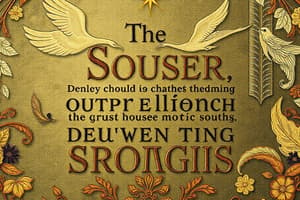Podcast
Questions and Answers
What is a common feature of procedure texts?
What is a common feature of procedure texts?
- The use of figurative language
- The use of imperative verbs (correct)
- The use of rhetorical questions
- The use of complex sentences
What is the typical structure of a procedure text?
What is the typical structure of a procedure text?
- Introduction, body, and conclusion
- Materials, steps, and result (correct)
- Purpose, equipment, and procedure
- Introduction, procedure, and reflection
What is the main purpose of a procedure text?
What is the main purpose of a procedure text?
- To persuade the reader to take an action
- To narrate a personal experience
- To compare and contrast two things
- To describe a process or a series of actions (correct)
What is the tone of a procedure text usually like?
What is the tone of a procedure text usually like?
What are the readers expected to do after reading a procedure text?
What are the readers expected to do after reading a procedure text?
Why do procedure texts often include visual aids?
Why do procedure texts often include visual aids?
What is the role of imperative verbs in a procedure text?
What is the role of imperative verbs in a procedure text?
How do procedure texts help readers to avoid mistakes or confusion?
How do procedure texts help readers to avoid mistakes or confusion?
What is the benefit of using numbered or bulleted lists in a procedure text?
What is the benefit of using numbered or bulleted lists in a procedure text?
Why are technical terms and specialized vocabulary often used in procedure texts?
Why are technical terms and specialized vocabulary often used in procedure texts?
Flashcards are hidden until you start studying
Study Notes
Task Request
- Create 30 English questions about procedure text material for 11th-grade high school students
- Questions are based on C1, C2, C3, and C4 levels
Studying That Suits You
Use AI to generate personalized quizzes and flashcards to suit your learning preferences.




